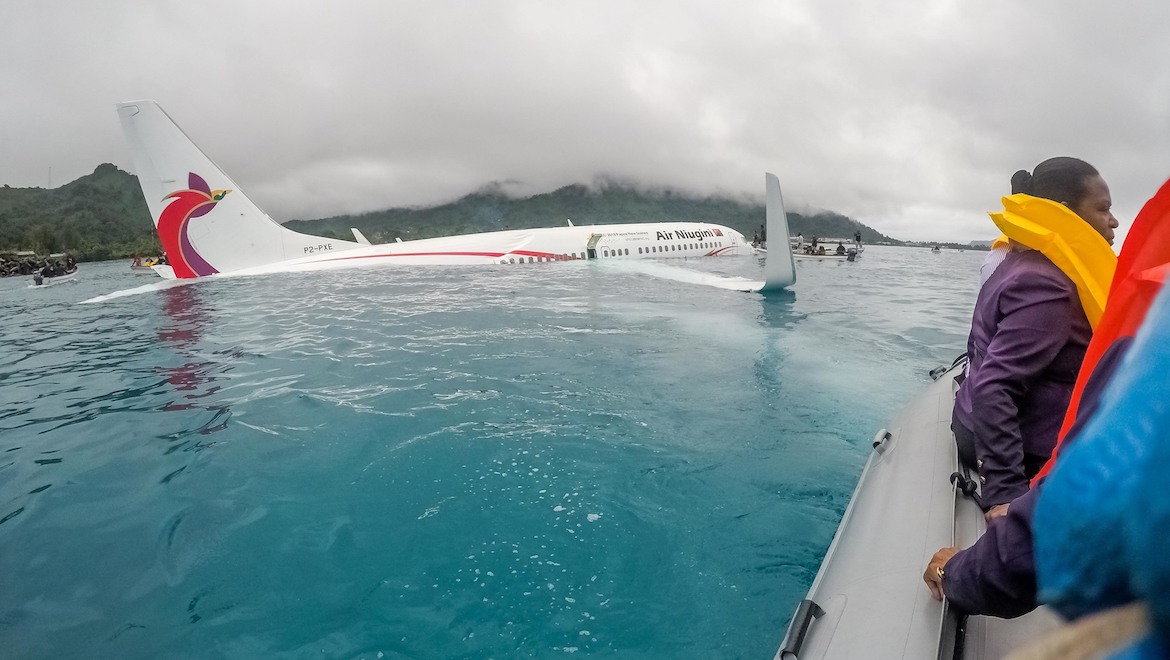
Papua New Guinea’s Accident Investigation Commission (AIC) has released its final report into the 2018 crash of an Air Niugini Boeing 737-800 into a lagoon at Chuuk Airport.
The incident occurred on September 28 2018, when the 737-800 P2-PXE landed in the lagoon some 1,500ft short of the Runway 04 threshold at Chuuk Airport in the Federated States of Micronesia.
Of the 47 passengers and crew on board, six suffered serious injuries and one person died. The aircraft sunk 30m below the surface of the water to lie on the bottom of the lagoon.
The AIC final report published on Thursday said the flight crew’s level of compliance with Air Niugini’s Standard Operating Procedures Manual (SOPM) was “not at a standard that would promote safe aircraft operations”.
Information retrieved from the flight data recorder (FDR) showed there were 17 Enhanced Ground Proximity Warning System (EGPWS) alerts, comprising eight for “Sink Rate” and nine for “Glideslope”.
Further, the cockpit voice recorder (CVR) indicated the pilots received 14 EGPWS aural alerts after passing the Minimum Descent Altitude (MDA), between 307 ft (364 ft) and the impact point.
This included a “100 ft” advisory, as well as seven for “Glideslope” and six for “Sink Rate”.
“The investigation observed that the flight crew disregarded the alerts, and did not acknowledge the ‘minimums’ and 100ft alerts; a symptom of fixation and channelised attention,” the AIC final report said.
“The crew were fixated on cues associated with the landing and control inputs due to the extension of 40° flap.
“Both pilots were not situationally aware and did not recognise the developing significant unsafe condition during the approach after passing the Missed Approach Point (MAP) when the aircraft entered a storm cell and heavy rain.”

The 737-800 was operating from Pohnpei, also part of the Federated States of Micronesia, to Chuuk. The flight was then scheduled to continue on to Port Moresby in Papua New Guinea.
The final report said the pilot in command intended to conduct a RNAV GPS approach to Runway 04. The descent and approach of the 737-800 was initially conducted in Visual Meteorological Conditions (VMC). Then, from 546ft, the aircraft was flown in Instrument Meteorological Conditions (IMC).
However, both pilots did not adhere to Air Niugini’s SOPM and the approach and pre-landing checklists, the final report said. Further, The RNAV (GPS) Runway 04 approach chart procedure was not adequately briefed.
While the RNAV approach specified a flight path descent angle of 3 degrees, the final report said the 737-800 was progressively flown below the glideslope on an approach path that averaged 4.5 degrees from 411ft to the point of impact.
It also found the approach became unstabilised with an excessively high rate of descent and lateral over controlling from 548ft.
“The copilot as the support/monitoring pilot was ineffective and was oblivious to the rapidly unfolding unsafe situation,” the final report said.
“He did not recognise the significant unsafe condition and therefore did not realise the need to challenge the PIC and take control of the aircraft, as required by the Air Niugini SOPM.”
VIDEO: A flight reconstruction of Air Niugini flight PX073 courtesy of the Papua New Guinea Accident Investigation Commission.
The final report said the copilot, who was the pilot monitoring, called out “Too low! We’re too low! We’re too low! We’re too low!” during one of the EGPWS aural warnings for “Sink Rate”.
Meanwhile, the recorded information showed the pilot in command had “lost situational awareness and that he was fixated on the task of completing the approach and landing the aircraft”.
“He continued the approach despite the excessive rate of descent while in IMC, and below the MDA,” the final report said.
The 52-year-old pilot in command had 2,276.4 hours on the 737, all of that time in command. The copilot had 368 hours on the type.
In addition to the CVR and FDR that were retrieved from the aircraft, investigators also utilised video footage of the final approach taken by an aircraft maintenance engineer taken from the jump seat in the flight deck.
PNG AIC chief commissioner Hubert Namani said the video “predominantly showed the cockpit instruments and provided clear imagery of the cockpit environment and instruments not available from the CVR or FDR”.
“The importance of the imagery obtained from the video taken by the engineer in the cockpit jump seat cannot be understated,” Namani said in a statement.
“Video imagery has the potential to save countless hours of investigation activity and greatly reduce the cost of investigations.”
Namani has proposed the Civil Aviation Safety Authority of PNG conduct a Notice of Proposed Rule Making process with the aim of requiring cockpit imagery in aircraft for safety enhancement benefits in an accident investigation.
This would ensure PNG was working to a higher level than the minimum Standard set by the International Civil Aviation Organisation (ICAO).
“Associated PNG legislation would ensure that cockpit imagery has the same legislative protections as the CVR. These protections are already in ICAO Annex 13 Standards,” Namani said.
“While the AIC accepts that PNG meets the Standards of ICAO with respect to recorded data and information, those ICAO Standards are global minimum Standards.”
Another recommendation in the report was for Honeywell to ensure that EGPWS provide “timely attention grabbing” aural and visual warnings that would require an immediate positive action by the pilots when encountering an excessive rate of descent at very low altitude.
“The AIC is continuing discussions with the NTSB, FAA, Honeywell and Boeing regarding research into this safety concern,” Namani said.
Chuuk Airport has a single asphalt runway 04/22 that measures 1,831m in length.
The PNG AIC investigation was assisted by the United States National Transportation Safety Board, the United States Federal Aviation Administration, Boeing and Honeywell.
The full report can be read on the PNG AIC website.
https://www.facebook.com/theaustralianaviation/videos/1878788628842685/
VIDEO: A United States Navy video of its Underwater Construction Team (UCT) helping rescue passengers from the Air Niugini Boeing 737-800 that landed in a Chuuk lagoon.












